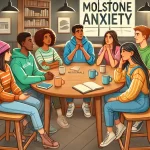Comfort characters and nostalgia candidly unify society’s struggle with mental health.
@gabzilla.rawr How are you doing? 😭 #elmo #mentalhealth #pokemongo #millennialmoments #trendingtopics #greenscreen
A surprising duo has emerged as the catalysts for a movement toward consistently honest communication and display of emotions. Elmo from “Sesame Street” and Steve from “Blue’s Clues”, iconic characters within the realm of children’s educational programing, have gone viral on social media with a simple question: “How are you doing?” This seemingly innocent inquiry has evolved into a powerful conversation about the realistic portrayal of one’s mood, resonating profoundly with Millennials and Generation Z who grew up with these beloved figures. The impact of Elmo and Steve’s unexpected outreach holds a safe space for fostering open discussions about mental health that span generations.
Elmo is just checking in! How is everybody doing?
— Elmo (@elmo) January 29, 2024
The social media response started innocently enough, with Elmo (on X) and Steve (on TikTok) genuinely asking their followers, “How are you doing?” The simplicity of the question, coupled with the nostalgia associated with these childhood characters, prompted a surge in responses from users across the platforms. What began as a lighthearted interaction quickly transformed into a collective outpouring of unfiltered emotions, personal experiences and a shared sense of vulnerability creating a sense of solidarity among strangers navigating the complexities of life.
The recent popularity of this movement can be traced back to Elmo’s initial foray into the world of existential questions. Elmo is an enthusiastically curious monster journeying through toddlerhood who is always eager to learn. He shares many elements of his life growing up on Sesame Street with monsters and humans his age ranging from his night time routine at a sleepover party with Abby to his first ride on a pogo stick.
He provides kids with love and support as they develop qualities that shape their confidence through many milestones. His positive outlook and endearing nature make him a perfect buddy for little humans who are navigating how the world functions and how they function in it. For Millennials and Generation Z, who are now finding their place in a complicated grown up world, Elmo checking in has ignited the voice of their inner child.
CBS News reported on the overwhelming response to Elmo’s tweet, showcasing the variety of emotions expressed by users. One person put it rather bluntly, “Elmo, I’m suffering from existential dread over here.” President Joe Biden even joined the conversation, acknowledging the challenging times saying, “I know how hard it is some days to sweep the clouds away and get to sunnier days … Even though it’s hard, you are not alone.”
@classyrican
Replies to Elmo t gained momentum to the point where Elmo and his Dad made an appearance on The Today Show where they discussed the significance of “big feelings” and the importance of emotional recognition.
Elmo also talked about the responsibility of asking how others are feeling and being prepared to listen no matter the response, in case someone “isn’t doing well.”
@cnn Sesame Street’s Elmo sat down with CNN’s Jake Tapper after a kind-hearted check-in this week on the social platform ‘X’ with the question: “How is everyone doing?” He sparked an online frenzy, bringing mental health crisis to light. #CNN #News #Elmo #JakeTapper #SesameStreet
Meanwhile, Steve Burns, the original host of “Blue’s Clues”, had been opening up about his own struggles with mental health. In an interview, Burns revealed that he experienced severe depression while filming the popular children’s show. His character is known for being warm, patient, animated and friendly. His goal is to foster thoughtful interactions that lead to insightful, inquisitive kids.
Steve’s personal revelation, that filming the show while pretending to be full of joy “became impossible,” resonated with many fans who remembered him fondly from their younger years. Burns had become not just a character molding enthusiastic curiosity but a relatable person managing the uncomfortable aspects of the unknown. His candor about mental illness laid the foundation for a more profound connection with his audience.
@1and1otc #steveburns reveals suffering from severe clinical depression while doing bluesclues, calling himself the “happiest depressed person in North America”. #1and1otc #mentalhealth #mentalhealthawareness #mentalhealthmatters
♬ Emotional Piano for the Soul (Inspirational Background Music) – Fearless Motivation Instrumentals
To further engage with the generation that grew up watching him on television, Burns joined TikTok using his memorable catchphrase: “Hi out there! It’s me, Steve.” In one of his first posts, he addresses the realities of adulthood: “We started out with clues and now it’s what? Student loans and jobs and families,” Burns said in the video. “And some of it has been hard,” he continued, “you know? I know you know. And I wanted to tell you I really couldn’t have done it all without your help. I never forgot you … ever. And I’m super glad we’re still friends.”
Now, he regularly checks in with his “friends” by asking them to fill him in on their lives, sipping coffee while providing space for them to authentically respond.
@hioutthereitsmesteve
One key element contributing to the success of this movement is the ever r potent force of nostalgia. Millennials and Generation Z, now adults, look back on their childhoods with a sense of longing and sentimentality. Elmo and Steve offer a judgment free safety akin to a security blanket that embodies a simpler time, a period of innocence and joy. This reminiscence creates a unique bond between the characters and their grown-up audience, fostering a comforting place for individuals to open up about where they are in their lives.
@treasureman #duet with @hioutthereitsmesteve Thank you for being my friend. I hope I’ve made you proud ❤️. #bluesclues #steve #fyp #foryou #emotional
Many people responded to Elmo and Steve with a remarkable display of authenticity. Comments feature heartfelt confessions, stories of resilience and expressions of support for others facing similar challenges. The responses are filled with words of encouragement, understanding and collective resonance. Threads under Steve and Elmo’s posts have evolved into a virtual support group, demonstrating the power of social media to foster honest communication and break down the taboos surrounding mental health.
@tiny_nightmare247 #duet with @hioutthereitsmesteve Steve helps us all. #fyp #trending #fypシ゚viral #fypシ
@jazzy_823 The world is falling apart and elmo’s like tehehe take care of your mental health! #elmo
The role that Elmo and Steve are filling for those coping with life’s obstacles has broader implications for how society approaches mental health topics. By leveraging the nostalgia associated with them as beloved childhood characters, they have successfully dismantled unrealistic, artificial attitudes that often prevent open discussions about genuine thoughts and emotions. The movement encourages individuals to be truthfully raw, knowing they are not isolated in their hardships.
As humans continue to open up to one another, Elmo and Steve’s initiative stands as a testament to the potential of social media in breaking down the stigma surrounding the need to appear okay or be permanently put together. In an age where online platforms often amplify negativity, this movement offers a refreshing reminder of the positive impact social media can have on generations of people.
Between 123 Sesame Street and the Thinking Chair, Elmo and Steve serve as a reminder that sincere communication and efforts to reach out to one’s we love can make all the difference. Mental health is a universal concern that transcends age, fame and societal expectations. Prominent figures, even those associated with children’s programming, are not immune to “big feelings.” By sharing their stories, both fictional and real, Elmo and Steve have played a crucial role in normalizing conversations about mental wellness. If you or anyone you know is struggling with mental health and looking for resources, please reach out to a trusted adult, friend, or health professional. You are not alone.

















